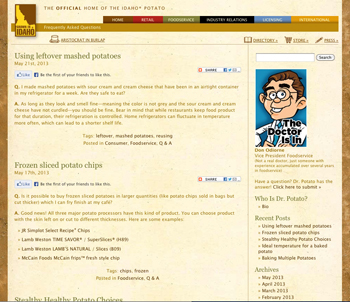Lesson Plan: Dr. Potato Has a New Address
Saturday, 01 June 2013 12:26
 Find answers to hot (and cold) potato questions at dr.idahopotato.com.
Find answers to hot (and cold) potato questions at dr.idahopotato.com.
The Dr. Potato Blog, the Idaho Potato Commission’s (IPC) popular resource for frequently asked questions about the state’s top crop, now has its own address. For answers to puzzling ingredient, technique and menu queries about Idaho® potatoes, the Doctor is in at dr.idahopotato.com. Even better, operators, educators and students will find useful tips for maximizing the appeal and profitability of Idahopotato offerings.
Don Odiorne, IPC vice president-foodservice and Idaho potato-industry veteran, applies his practical and culinary experience to each response. His current posts tackle timely topics like healthy Idaho potato-menu options, the best internal temperature for a baked Idaho potato and techniques for baking 50 Idahopotatoes at a time.
Submit an Idaho potato question to Dr. Potato at dr.idahopotato.com. To browse the Idaho Potato Commission’s foodservice-recipe database, “Passionate About Potatoes” foodservice ad campaign, and shippers and processor directory, or to download the Idaho Potato Commission Foodservice Toolkit, visit foodservice.idahopotato.com.
To order a “Passionate About Potatoes” chef recipe set, email the Idaho Potato Commission at This email address is being protected from spambots. You need JavaScript enabled to view it. or call (208) 334-2350.

 A significant profit center in any foodservice operation is energy efficiency and savings.
A significant profit center in any foodservice operation is energy efficiency and savings. As cooks, we exist to express ourselves, learn and work together as a team and produce some amazing art that people in the dining room will eat, smell and enjoy.
As cooks, we exist to express ourselves, learn and work together as a team and produce some amazing art that people in the dining room will eat, smell and enjoy.